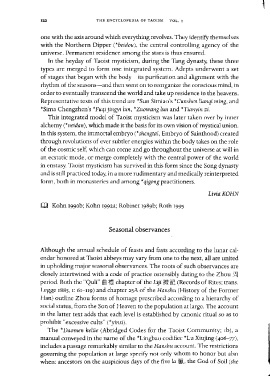Page 162 - The Encyclopedia of Taoism v1_A-L
P. 162
122. THE ENCYCLOPEDIA OF TAOISM VOL. I
one with the axis around which everything revolves. They identify themselves
with the Northern Dipper (*beidou), the central controlling agency of the
universe. Permanent residence among the stars is thus ensured.
In the heyday of Taoist mysticism, during the Tang dynasty, these three
types are merged to form one integrated system. Adepts underwent a set
of stages that began with the body-its purification and alignment with the
rhythm of the seasons-and then went on to reorganize the conscious mind, in
order to eventually transcend the world and take up residence in the heavens.
Representative texts of this trend are *Sun Simiao's *Cunshen lianqi ming, and
*Sima Chengzhen's *Fuqi jingyi lun, *Zuowang lun and *Tianyin zi.
This integrated model of Taoist mysticism was later taken over by inner
alchemy (*neidan), which made it the basis for its own vision of mystical union.
In this system, the immortal embryo (*shengtai, Embryo of Sainthood) created
through revolutions of ever subtler energies within the body takes on the role
of the cosmic self, which can come and go throughout the universe at will in
an ecstatic mode, or merge completely with the central power of the world
in enstasy. Taoist mysticism has survived in this form since the Song dynasty
and is still practiced today, in a more rudimentary and medically reinterpreted
form, both in monasteries and among *qigong practitioners.
LiviaKOHN
m Kohn 1990b; Kohn I992a; Robinet 1989b; Roth I995
Seasonal observances
Although the annual schedule of feasts and fasts according to the lunar cal-
endar honored at Taoist abbeys may vary from one to the next, all are united
in upholding major seasonal observances. The roots of such observances are
closely intertwined with a code of practice ostensibly dating to the Zhou J.'i]
period. Both the "Quli" BB:f! chapter of the Liji :f! ~c (Records of Rites; trans.
Legge I885, I: 6I-II9) and chapter 25A of the Hanshu (History of the Former
Han) outline Zhou forms of homage prescribed according to a hierarchy of
social status, from the Son of Heaven to the population at large. The account
in the latter text adds that each level is established by canonic ritual so as to
prohibit "excessive cults" (*yinsi).
The *Daomen keliie (Abridged Codes for the Taoist Community; Ib), a
manual conveyed in the name of the *Lingbao codifier *Lu Xiujing (406-77),
includes a passage remarkably similar to the Hanshu account. The restrictions
governing the population at large specify not only whom to honor but also
when: ancestors on the auspicious days of the five la Bm, the God of Soil (she

